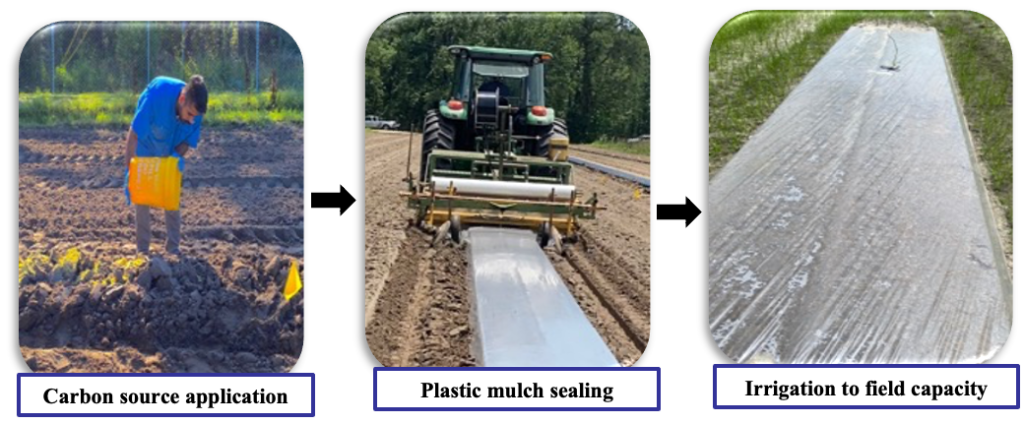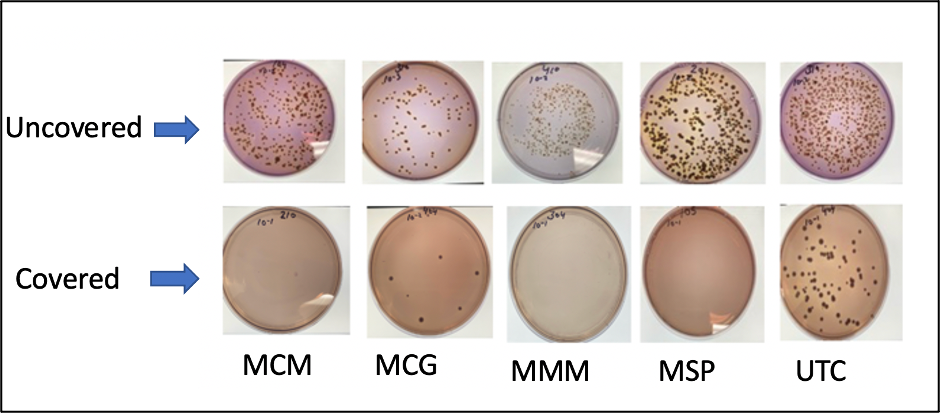By Matthew Cutulle
Soil-borne pathogenic bacteria, fungi and other microorganisms cause approximately 90% of diseases affecting the most widely cultivated agricultural crops in the United States. These soil-borne pathogens are among the most damaging factors in crop productivity affecting yield, plant vigor and overall marketability.
One of the most problematic pathogens that growers in the Southeast deal with is the bacterium Ralstonia solanacearum, which causes bacterial wilt in solanaceous plants. It is extremely prevalent in southern soils and affects a variety of crops. Once present in the field, bacterial wilt is challenging to control due to its prevalence in the soil. Chemical controls that provide effective management are not available. Current control measures for bacterial wilt include biocontrol agents, oil treatments, soil biofumigation and lime application.
ANAEROBIC SOIL DISINFESTATION
One of the most promising regenerative agricultural treatments is anaerobic soil disinfestation (ASD). ASD creates limited anaerobic conditions in the top layer of soil, which can kill weeds, pathogens and nematodes.
ASD can be initiated by amending the soil with a carbon source and incorporating the carbon source into the soil with a peanut hoe or similar apparatus. This is followed by tarping with an impermeable film or cover and then irrigating until close to the soil saturation point (Figure 1). ASD creates anaerobic conditions that eliminate the oxygen that many agricultural soil-borne diseases require to survive. Additionally, the breakdown of carbon sources and change of microbial composition leads to the production of volatile organic compounds that can be toxic to plant pathogens. Furthermore, the temporary decrease in soil pH is not ideal for aerobic plant pathogens.

ASD was first initially used in the Netherlands and Japan in the early 2000s. In the United States, ASD has been successfully implemented on a large scale in California organic strawberry production and in Florida strawberry, tomato, pepper and eggplant crops.
A key to sustainably implementing ASD in a region is dependent on the availability of economically viable and effective carbon sources. Rice bran is readily available in California and effectively drives down the redox potential of the soil, which makes it more anaerobic. In Florida molasses, waste from sugar cane fields coupled with chicken poultry litter has shown to be an effective locally available carbon source. In South Carolina, ASD is just starting to be implemented in solanaceous and cucurbit crops. Cotton seed meal has been explored as a carbon source because of the proximity of local cotton-processing facilities to vegetable production.
Numerous carbon sources have been evaluated and found to be beneficial across a range of crops, soils and environmental conditions. The majority of carbon sources are derived from agricultural wastes. Rice and wheat brans, sugarcane-molasses products, ethanol, crop residual waste, fruit-processing waste, various manures such as poultry manure, cotton and brassica seed meal, brewer’s spent grains and cover crops have all been shown to be effective as ASD carbon amendments.
BACTERIAL WILT TRIAL
A greenhouse tomato trial was conducted at the Clemson Coastal Research and Education Center to evaluate the effectiveness of four carbon sources on bacterial wilt suppression. These carbon sources included mustard meal and molasses (MMM), molasses and chicken manure (MCM), molasses and corn gluten meal (MCG) and molasses and sweet potato (MSP). The sweet potato waste was recovered from a local cannery.
Findings are consistent with previous ASD work in which wheat bran was used as a carbon source and the population of bacterial wilt decreased below the detection limit (Momma, 2008). The effect of ASD was observed in this study as the experimental buckets with only plastic covering and no carbon amendment, which were exposed to the same conditions as the ASD ones, did not exhibit a decline in bacterial wilt populations. Similar effects were observed in a previous study amended with fresh grass as a carbon source (Messiha et al., 2007). The soil environment created by ASD is inhospitable for plant pathogens because of low soil-redox potential and the generation of toxic volatile and non-volatile fatty acids by the decomposition of carbon sources by soil microbial populations (Momma, 2015).
The greater control of bacterial wilt observed in MMM-amended ASD-treated soil may be due to biocidal effects of isothiocyanates produced by mustard meal (Figure 2). Results indicate mixed carbon sources and sealed treatments have the potential to suppress bacterial wilt populations in soil and reduce bacterial wilt incidence in greenhouse bucket experiments.

The choice of carbon source plays a critical role in the efficacy of ASD. For instance, MCG and MSP amended ASD was comparatively less effective in suppressing bacterial wilt than MMM and MCM. Since these carbon sources or their components under anaerobic conditions have been reported to have fungicidal, nematocidal and antibacterial activities they could be used in integrated pest management in tomato. However, further research is needed to assess the efficacy of carbon sources in managing tomato bacterial wilt in field conditions with high population densities.
CONCLUSION
Currently, implementing sustainable practices is essential for meeting long-term agricultural demands by using farm-based, environmentally friendly resources, which do not degrade the environment. The potential of ASD to control soil-borne plant pathogens in specialty crop production is exciting. I encourage you to work with your horticulturalist on identifying local carbon sources that are economically and biologically viable for facilitating ASD.
Matthew Cutulle is an assistant professor at the Clemson University College of Agriculture, Forestry and Life Sciences Coastal Research and Education Center in Charleston, South Carolina.









